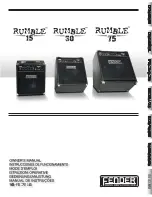
The Technical Stuff
__________________________________________________________
- 12
-
recording consoles. It featured input and output transformers, with connections for modular equalizers
such as the UA 508 EQ. This amp design became the basis for the enormously popular 1176 limiter,
which utilized the same output transformer. Interestingly, the 1108 has probably been used on many
more classic recordings than the 610, due to its broad popularity.
Throughout the years, solid-state preamplifiers have evolved into ever more sophisticated designs
(such as the Precision mic preamp utilized in the Universal Audio SOLO/110 and multichannel
4110/8110, and the transimpedance design first unveiled in the Universal Audio DCS Remote Preamp).
Until fairly recently, solid-state models were the norm in recording studios, but somewhere around the
explosion of digital recording, tube preamps suddenly became fashionable again, serving for some as
the antidote to so-called “cold” DAWs. Despite the fact that technology has vastly improved the quality
of even the least expensive converters and that higher sample rates and bit rates are commonly being
used, many still find something unforgiving about the medium. But there is more than one way to skin
the digital cat, and nowadays engineers reach for those tools that inject the correct character back
into what some call an overly critical medium.
The key is knowing
which
tools to reach for... and, in the case of preamplifiers, whether to opt for the
“warmth” of tubes or the precision of solid-state. The Universal Audio 710 Twin-Finity allows the
recordist to literally enjoy the best of both worlds. Not only does it combine two preamplifiers—one
vaccum tube and one solid-state—in a single box, its unique Blend control allows the engineer to dial
in precisely the desired amount of tone from each. The 710 is truly a cutting-edge product for its time.
In 2000, Bill Putnam Sr. was awarded a Technical Grammy for his multiple contributions to the
recording industry. Highly regarded as a recording engineer, studio designer/operator and inventor,
Putnam was considered a favorite of musical icons Frank Sinatra, Nat King Cole, Ray Charles, Duke
Ellington, Ella Fitzgerald and many, many more. The studios he designed and operated were known for
their sound and his innovations were a reflection of his desire to continually push the envelope.
Universal Recording in Chicago, as well as Ocean Way and Cello Studios (now EASTWEST) in Los
Angeles all preserve elements of his room designs.
The companies that Putnam started—Universal Audio, Studio Electronics, and UREI—built products
that are still in regular use decades after their development. In 1999, his sons Bill Jr. and James
Putnam re-launched Universal Audio and merged with Kind of Loud technologies—a leading audio
software company—with two goals in mind: to reproduce classic analog recording equipment
designed by their father and his colleagues, and to design new recording tools in the spirit of vintage
analog technology. Today Universal Audio is fulfilling that goal, bridging the worlds of vintage analog
and DSP technology in a creative atmosphere where musicians, audio engineers, analog designers and
DSP engineers intermingle and exchange ideas. Every project taken on by the UA team is driven by its
historical roots and a desire to wed classic analog technology with the demands of the modern digital
studio.












































